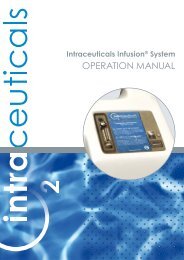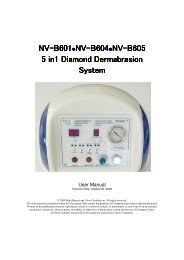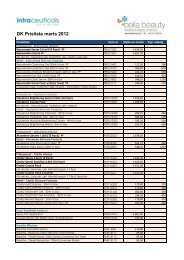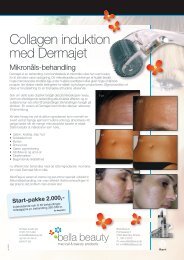Use of Intense Pulsed Light (IPL) in Indian Skin Types - ResearchGate
Use of Intense Pulsed Light (IPL) in Indian Skin Types - ResearchGate
Use of Intense Pulsed Light (IPL) in Indian Skin Types - ResearchGate
- No tags were found...
Create successful ePaper yourself
Turn your PDF publications into a flip-book with our unique Google optimized e-Paper software.
<strong>Intense</strong> <strong>Pulsed</strong> <strong>Light</strong> DeviceAn iPulse i200 (CyDen Ltd., Swansea, United K<strong>in</strong>gdom) <strong>in</strong>tense pulsed light device was used for all treatments. This novel<strong>IPL</strong> was chosen because <strong>of</strong> its constant spectral output pr<strong>of</strong>ile and it was hypothesized that the time-resolved constantspectrum output between 530 nm and 1200 nm for the entire pulse duration claimed by the manufacturer would ensureefficient and stable delivery <strong>of</strong> energy to the dark <strong>Indian</strong> sk<strong>in</strong> types <strong>in</strong> the study and reduce the side effects <strong>of</strong>ten associatedwith conventional, free-discharge <strong>IPL</strong> devices when used to treat dark sk<strong>in</strong>s [24].Treatment procedurePre- and post-treatment photography was used. The treatment area was shaved and cleaned and the area covered withchilled ultrasound gel. The <strong>IPL</strong> treatment program and fluence was chosen based on sk<strong>in</strong> condition, sk<strong>in</strong> type and reactionto <strong>in</strong>itial test patch treatments. After treatment, cool<strong>in</strong>g gel packs were applied to the area. Aloe vera cream was gentlyrubbed <strong>in</strong>to the treated area when the treatment session was completed. No other creams or preparations were usedexcept <strong>in</strong> cases <strong>of</strong> melasma where hydroqu<strong>in</strong>one (2%) cream was used as an adjunctive treatment. Those who weresatisfied with results at follow-up or did not wish to cont<strong>in</strong>ue received no further treatment. Patients who were not satisfiedcould receive further treatment sessions with the same protocol as above, until the f<strong>in</strong>al assessment po<strong>in</strong>t when the patientand dermatologist felt satisfied with the result, or agreed that no further improvement could be seen.Figure 1—iPulse i200+(CyDen Ltd., Swansea, UK) tw<strong>in</strong>-lamp, constantspectrum <strong>IPL</strong> system used <strong>in</strong> the study.Figure 2—(Above) Schematic illustration <strong>of</strong> the difference <strong>in</strong> spatialand temporal pr<strong>of</strong>ile <strong>of</strong> a free discharge and partial discharge pulse.(Below) Time resolved spectral measurements us<strong>in</strong>g an OceanOpticsspectrometer and Spectrasuite counterpart s<strong>of</strong>tware show<strong>in</strong>g spectral “jitter”versus constant spectral emission [24].4
Results & DiscussionThe groups comprised hair removal: n=53; acne: n=35 and pigmentation: n=59. The overall average fluence used was11.6, 10.5 and 12.3 J/cm 2 respectively.The study was conducted <strong>in</strong> Chennai city <strong>in</strong> Southern India where the normal range <strong>of</strong> sk<strong>in</strong> types <strong>of</strong> patients seek<strong>in</strong>g treatmentis Fitzpatrick IV-V and the sunny climate is constantly hot and humid with an average ambient temperature even <strong>in</strong> airconditionedrooms above 25ºC. These climatic conditions <strong>in</strong>crease treatment-related problems and <strong>in</strong>crease the <strong>in</strong>cidence <strong>of</strong>post-treatment side effects aggravated by sun exposure to sk<strong>in</strong> areas exposed to <strong>in</strong>tense pulsed light or laser wavelengths.It is reasonable to assume that certa<strong>in</strong> pigmented lesions may be diagnosed accurately by an expert dermatologist asbenign without the benefit <strong>of</strong> histological validation (impossible where the treatment with light therapy is entirely non-<strong>in</strong>vasiveand no tissue is removed dur<strong>in</strong>g the procedure).The generally poor response after only one or two treatments confirms the importance <strong>of</strong> complet<strong>in</strong>g a course <strong>of</strong> <strong>IPL</strong>treatments at regular <strong>in</strong>tervals. Patients who failed to attend sufficient treatment sessions, showed reduced effectiveness asassessed by the expert cl<strong>in</strong>ician. Where more treatment sessions were given, <strong>in</strong> most cases better results were observed.In common with other anecdotally reported experience with laser and <strong>IPL</strong> devices <strong>in</strong> India, a conservative approach isnormally taken to choos<strong>in</strong>g treatment parameters and it is generally found that numbers <strong>of</strong> treatments needed to achievesatisfactory results are greater than <strong>in</strong> countries with lighter sk<strong>in</strong> types and even where treatment energy levels are similar,more treatments appear to be necessary.EfficacyTreatment outcomes were only assessed and recorded atthe end <strong>of</strong> a treatment or course <strong>of</strong> treatments when thepatient and/or dermatologist were satisfied that no furtherimprovement could be achieved, where the patient did notwish to cont<strong>in</strong>ue or where the patient simply failed to appearfor further scheduled treatments. The standard descriptions<strong>of</strong> efficacy used <strong>in</strong> this study by the expert cl<strong>in</strong>ical assessorwere graded and assessed as follows:Hair Reduction:Grade 0 = No reduction (25%),Grade 2 = Moderate Reduction (>50%),Grade 3 = Good Reduction (>70%).As expected, where multiple treatments were given thegreatest degree <strong>of</strong> hair reduction was achieved. In general,there was little reduction <strong>in</strong> regrowth <strong>of</strong> hair follicles after as<strong>in</strong>gle treatment, a moderate reduction only after 3-4treatments and <strong>in</strong> two cases <strong>of</strong> thick, facial hair, a goodreduction after 7 treatments. Table 2 <strong>in</strong>dicates better results <strong>in</strong>fewer treatments for cosmetic hair removal versus hirsutism.Intervals between treatments needed to be 3-4 weeks and thetrial subjects did not always follow this.There were fewer cases <strong>of</strong> cosmetic hair removal on bodyareas than might be seen <strong>in</strong> comparable studies <strong>in</strong> lighter sk<strong>in</strong>types. This is probably expla<strong>in</strong>ed by cultural preferences andtraditional <strong>Indian</strong> garment design.Figure 3—Hirsutism: Female, age 20 yrs, sk<strong>in</strong> type V, 50% reduction withregrowth <strong>of</strong> f<strong>in</strong>er lighter hair. 6 treatments at irregular <strong>in</strong>tervals over 10 monthsus<strong>in</strong>g a fluence <strong>of</strong> 11-13 J/cm2, triple sub-pulses: 14 ms on, 7 ms <strong>of</strong>f.Satisfaction3Significantreduction2Moderatereduction1Somereduction0No reductionCosmeticHisuitism1 2 3 4 5 6 7No. <strong>of</strong> treatmentsFigure 4—Hair Removal: Graph show<strong>in</strong>g patient satisfaction,with progressively better results with <strong>in</strong>creas<strong>in</strong>g numbers <strong>of</strong> treatments<strong>in</strong> both hirsutism and purely cosmetic hair removal cases5
No. treatments 1 2 3 4 5 6 7Hirsutism 0.1 0.4 1.2 1.5 2.5 1.0 3.0Acne Improvement:(n = 16) (n = 7) (n = 5) (n = 4) (n = 2) (n = 1) (n = 2)Cosmetic 0.5 1.0 2.0 2.3 - - -(n = 6) (n = 20) (n = 3) (n = 3) - - -0 = No reduction (25%),2 = Moderate Reduction (>50%),3 = Significant Reduction (>70%).The improvement <strong>in</strong> results with <strong>in</strong>creas<strong>in</strong>g numbers <strong>of</strong> treatments was best shown <strong>in</strong> acne improvement grades with somereduction achieved <strong>in</strong> only two treatments.3SignificantreductionTable 2—Hair removalAverage treatment grad<strong>in</strong>g scores with different numbers <strong>of</strong> treatments for hirsutism and cosmetic facial hair removal.0 = No reduction (25%), 2 = Moderate Reduction (>50%), 3 = Good Reduction (>70%).Satisfaction2Moderatereduction1Somereduction0No reduction1 2 3 4 5 7 10No. <strong>of</strong> treatmentsFigure 5—Acne improvement: Graph show<strong>in</strong>g patient satisfaction withsome reduction achieved <strong>in</strong> only two treatments.Figure 6—Acne: Female, age 20 yrs, sk<strong>in</strong> type V, before and three monthsafter (5 treatments at 2-3 week <strong>in</strong>tervals us<strong>in</strong>g a fluence <strong>of</strong> 10 J/cm 2 ,s<strong>in</strong>gle 50 ms pulse).No. treatments 1 2 3 4 5 7 10Facial acne 0.4 1.2 1.7 2.0 3.0 3.0 3.0Pigmented Lesions:0 = No <strong>Light</strong>en<strong>in</strong>g (25%),2 = Moderate <strong>Light</strong>en<strong>in</strong>g (>50%),3 = Good <strong>Light</strong>en<strong>in</strong>g (>70%)4 = Complete Clearance (>90%).(n = 18) (n = 9) (n = 3) (n = 2) (n = 1) (n = 1) (n = 1)Table 3—AcneAverage treatment grad<strong>in</strong>g scores for facial acne. 0 = No reduction (25%),2 = Moderate Reduction (>50%), 3 = Significant Reduction (>70%)Cl<strong>in</strong>ically assessed improvement (lighten<strong>in</strong>g) <strong>of</strong> pigmented lesions ranged from “no lighten<strong>in</strong>g” at all to “complete clearance”.Where multiple treatments were undertaken the greatest degree <strong>of</strong> lighten<strong>in</strong>g was achieved. With freckles, melasma andpost-<strong>in</strong>flammatory hyperpigmentation (PIH), multiple treatments were needed to produce satisfactory results.Café au lait did not respond even after 3 treatments.6
Becker’s Naevus – S<strong>in</strong>gle treatments were completely <strong>in</strong>effective, multiple treatments on the thigh <strong>of</strong> one patient weresimilarly <strong>in</strong>effective and one case showed darken<strong>in</strong>g <strong>of</strong> the naevus at 4 weeks post treatment. This was probably due to thedeep location <strong>of</strong> the pigment.Figure 7—Freckles: Female, age 23 yrs, sk<strong>in</strong> type V, before and one monthafter (two treatments at 2 week <strong>in</strong>tervals us<strong>in</strong>g a fluence <strong>of</strong> 13 J/cm 2 ,triple sub-pulses: 10 ms on, 15 ms <strong>of</strong>f).Figure 8—Melasma: Female, age 30 yrs, sk<strong>in</strong> type IV, before and sevenweeks after (five treatments at weekly <strong>in</strong>tervals us<strong>in</strong>g a fluence <strong>of</strong> 13 J/cm 2 ,triple sub-pulses 10 ms on, 20 ms <strong>of</strong>f.)Figure 9—Melasma: Female age 56 yrs, sk<strong>in</strong> type V, before and after48 weeks (three treatments at 40 day <strong>in</strong>tervals, 12-14 J/cm2,triple sub-pulses 14 ms on, 7 ms <strong>of</strong>f).Figure 10—Melasma Side Effects: Female, age 42 yrs, sk<strong>in</strong> type V, beforeand 4 days post treatment show<strong>in</strong>g typical temporary depigmentationfollow<strong>in</strong>g crust<strong>in</strong>g 13 J/cm 2 , triple sub-pulses: 14 ms on, 7 ms <strong>of</strong>f.No. treatments 1 2 3 4 5 6Becker’s 0.0 - - 0.0 - -(n = 2) - - (n = 1) - -Freckles 0.3 1.2 2.0 1.5 - -(n = 7) (n = 5) (n = 1) (n =2) - -Melasma 0.1 1.0 1.0 1.0 2.0 -(n = 7) (n = 1) (n = 1) (n = 1) (n = 1) -Pigment 0.1 1.0 0.8 2.2 - 0.0(n = 12) (n = 4) (n = 4) (n = 5) - (n = 1)PIH 0.0 - - - 2.0 -(n = 0) - - - (n = 2) -Total scores 0.1 1.1 1.0 1.7 2.0 0.0(n = 30) (n = 10) (n = 6) (n = 9) (n = 3) (n = 1)Table 4—PigmentationAverage treatment grad<strong>in</strong>g scores for pigmentation. 0 = No <strong>Light</strong>en<strong>in</strong>g (25%),2 = Moderate <strong>Light</strong>en<strong>in</strong>g (>50%), 3 = Good <strong>Light</strong>en<strong>in</strong>g (>70%) 4 = Complete Clearance (>90%).7
Satisfaction3Significantreduction2Moderatereduction1SomereductionTotal scoresPIHPigmentMelasmaFreckles0No reduction1 2 3 4 5 6No. <strong>of</strong> treatmentsFigure 11—Pigmentation: Graph show<strong>in</strong>g patient satisfaction, with some reduction <strong>in</strong> PIH, pigment,melasma and freckles after only two treatments and progressively better results with more treatments.Side Effects & Treatment-related ProblemsSide effects and treatment-related problems were assessed to range from “none” to “severe superficial burns” across alltreatment types <strong>in</strong>cluded <strong>in</strong> the study. Treatment-related problems are considered to be normal <strong>in</strong> <strong>IPL</strong> treatments and <strong>in</strong> thisstudy <strong>in</strong>cluded sk<strong>in</strong> reactions follow<strong>in</strong>g treatment up to and <strong>in</strong>clud<strong>in</strong>g severe erythema <strong>in</strong> hair removal, mild to normalerythema <strong>in</strong> acne cases and darken<strong>in</strong>g <strong>of</strong> pigmented areas or temporary crust<strong>in</strong>g. In the case <strong>of</strong> pigmentation treatments,temporary crust<strong>in</strong>g <strong>of</strong> epidermal lesions, which sloughs <strong>of</strong>f with<strong>in</strong> 7-10 days dur<strong>in</strong>g normal wash<strong>in</strong>g was dist<strong>in</strong>guished fromtransient hyperpigmentation that lasted several weeks to several months and was considered a true side effect.T. Alster reported a significant <strong>in</strong>cidence <strong>of</strong> side effects [25] <strong>in</strong> darker sk<strong>in</strong> phototypes follow<strong>in</strong>g laser treatment andrecommended prophylactic application <strong>of</strong> SPF30+ sun screen <strong>in</strong>itiated at least three to four months before laser surgery toavoid post-<strong>in</strong>flammatory hyperpigmentation. No such precautions were taken <strong>in</strong> this study when us<strong>in</strong>g <strong>IPL</strong> therapy.Normal side effects No. Patients (%) No. <strong>in</strong>cidents Av. pa<strong>in</strong> score Areas Side effect(s)Acne 5 (14.3) 5 39.8 Face Mild erythemaHair removal 12 (28.8) 17 45.5 Face Mild erythemaPigment 20 (33.9) 21 46.6 Face, thigh (1), chest (1) Mild erythemaTrue side effectsAcne 0 (0) 0 n/a n/a n/aHair removal 3 (5.7) 5 47.5 Face, legs (1) Burns (1), erythemaPigment 2 (3.7) 3 48.7 Face Burns (1), erythema (2)The standard descriptions <strong>of</strong> side effects used <strong>in</strong> this study by the expert cl<strong>in</strong>ical assessor were graded as follows:Hair Removal:Table 5—Side effects0 = None,1 = Mild Erythema,2 = Erythema (e.g. Perifollicular Oedema),3 = Severe Erythema,4 = Crust<strong>in</strong>g (eg. <strong>in</strong>clud<strong>in</strong>g transient hyperpigmentation),5 = Severe Superficial Burns (eg. <strong>in</strong>clud<strong>in</strong>g hypopigmentation).8
Acne:0 = None,1 = Mild to Normal Erythema,2 = Hyperpigmentation,3 = Severe Superficial Burns.All acne patients showed a reduction <strong>in</strong> the number <strong>of</strong> <strong>in</strong>flamed lesions with no side effects. The reduction <strong>of</strong> acne spotsobserved was similar to results reported <strong>in</strong> the literature for lighter sk<strong>in</strong> types treated with <strong>IPL</strong>.Pigment:0 = None,1 = Mild to Normal Erythema / darken<strong>in</strong>g <strong>of</strong> pigmented lesion / crust<strong>in</strong>g,2 = Hyperpigmentation,3 = Severe Superficial Burns,4 = Hypopigmentation.Normal erythema was only seen <strong>in</strong> about one third <strong>of</strong> patients suggest<strong>in</strong>g an over-cautious approach. Side effects wereseen with <strong>in</strong>creased fluence. Two cases <strong>of</strong> post hair removal treatment burns were reported. The consequentialhyperpigmentation resolved <strong>in</strong> both <strong>of</strong> these cases with<strong>in</strong> 3 months (See figures 7-9).Pa<strong>in</strong>Pa<strong>in</strong> experienced by the patients dur<strong>in</strong>g all <strong>of</strong> the treatments was graded us<strong>in</strong>g a blank visual analogue scale (0 = no pa<strong>in</strong>at all and 10 = worst pa<strong>in</strong> imag<strong>in</strong>able). Average pa<strong>in</strong> scores for hair removal, acne and pigmentation were 4.5, 4.7 and 4.2respectively. Most subjects found the level <strong>of</strong> discomfort easily tolerated and no subjects felt the pa<strong>in</strong> was unbearable as noscores were recorded above 7.0 (See figure 10).9
ConclusionsWhen a sufficient number <strong>of</strong> treatments were performed, the iPulse constant spectrum <strong>IPL</strong> was found to be effective <strong>in</strong> thisprelim<strong>in</strong>ary study <strong>in</strong> the treatment <strong>of</strong> benign pigmented lesions, acne and <strong>in</strong> the long-term delay <strong>of</strong> hair regrowth <strong>in</strong> hirsutism.Normal treatment related problems <strong>in</strong>clud<strong>in</strong>g patient assessed pa<strong>in</strong> response and side effects us<strong>in</strong>g the iPulse <strong>IPL</strong> with itsconstant spectral output, large 8.9 cm 2 spot size and relatively low fluence characteristics, were found to be comparable<strong>in</strong> dark <strong>Indian</strong> sk<strong>in</strong> to those reported <strong>in</strong> the literature <strong>in</strong> lighter sk<strong>in</strong> types with conventional <strong>IPL</strong> devices. Early <strong>in</strong>dications<strong>of</strong> efficacy <strong>in</strong> the treatment <strong>of</strong> hirsutism, pigmentation and acne were broadly similar to lasers and other <strong>IPL</strong> systems <strong>in</strong>lighter sk<strong>in</strong> types.Both the follow-up period and the number <strong>of</strong> lesions <strong>in</strong>cluded <strong>in</strong> the present study may not be sufficient to fully evaluatethe potentials <strong>of</strong> this treatment modality as well as the true <strong>in</strong>cidence <strong>of</strong> recurrence <strong>of</strong> the orig<strong>in</strong>al condition. Therefore, theresults obta<strong>in</strong>ed should be confirmed <strong>in</strong> larger studies.10
References1. Alster TS. Complete elim<strong>in</strong>ation <strong>of</strong> large café-au-lait birthmarks by the510-nm pulsed dye laser. Plast Reconstr Surg 1995; 95: 1660–4.2. Trelles MA, Verkruysse W, Picker<strong>in</strong>g JW, et al. Monol<strong>in</strong>e argon laser(512 nm) treatment <strong>of</strong> benign pigmented lesions with long pulse length.J Photochem Photobiol 1992; 16:357–65.3. Alster TS, Williams CM. Cafe-au-lait macule <strong>in</strong> type V sk<strong>in</strong>: successfultreatment with a 510 nm pulsed dye laser. J Am Acad Dermatol 1995;33: 1042–3.4. Somyos K, Boonchu K, Somsak K, et al. Copper vapour laser treatment<strong>of</strong> cafe-au-lait macules. Br J Dermatol 1996; 135:964–8.5. Fitzpatrick RE, Goldman MP, Ruiz-Esparza J. Laser treatment <strong>of</strong> benignpigmented epidermal lesions us<strong>in</strong>g a 300 nsecond pulse and 510 nmwavelength. J Dermatol Surg Oncol 1993; 19:341–7.6. Chu A, Cunliffe WJ. <strong>Pulsed</strong>-dye laser treatment for <strong>in</strong>flammatory acnevulgaris: randomised controlled trial. Lancet. 2003; 362:1347-1352.7. Butterwick KJ, Butterwick LS, Han A. Laser and light therapies for acnerosacea. J Drugs Dermatol. 2006; 5(1):35-9.8. Gold MH, Bell MW, Foster TD, Street S. One-year follow-up us<strong>in</strong>g an<strong>in</strong>tense pulsed light source for long-term hair removal. J Cutan LaserTher. 1999 1(3):167-71.9. Omi T, Clement M. The use <strong>of</strong> a constant spectrum, uniform temporalpr<strong>of</strong>ile <strong>in</strong>tense pulsed light long-term hair removal <strong>in</strong> Asian sk<strong>in</strong>. JCosmetic Laser Ther. 2006; 8:138-145.10. Bedewi AF. Hair removal with <strong>in</strong>tense pulsed light. Lasers Med Sci.2004; 19(1):48-51.11. Bjerr<strong>in</strong>g P, Cramers M, Egekvist H, Christiansen K, Troilius A. Hairreduction us<strong>in</strong>g a new <strong>in</strong>tense pulsed light irradiator and a normal moderuby laser. J Cosmetic Laser Ther. 2006. 2(2):63-71.References16. Anderson RR, Margolis RJ, Watanabe S, et al. Selectivephotothermolysis <strong>of</strong> cutaneous pigmentation by Q-switched Nd:YAGlaser pulses at 1064 nm, 532 and 355 nm. J Invest Dermatol1989; 93:28-32.17. Kono T, Manste<strong>in</strong> D, Chan HH, Nozaki M, Anderson RR. Q-SwitchedRuby Versus Long-<strong>Pulsed</strong> Dye Laser Delivered With Compression forTreatment <strong>of</strong> Facial Lentig<strong>in</strong>es <strong>in</strong> Asians. Lasers Surg Med 2006; 38:94-97.18. Grevl<strong>in</strong>k JM, van Leeuwen RI, Anderson RR, et al. Cl<strong>in</strong>ical andhistological responses <strong>of</strong> congenital melanocytic nevi after a s<strong>in</strong>gletreatment with Q-switched lasers. Arch Dermatol 1997; 133:349-53.19. Goldberg DJ. Laser treatment <strong>of</strong> pigmented lesions. Dermatol Cl<strong>in</strong>1997; 15:397-407.20. Kopera D, Hohenleutner U, Landthaler M. Quality-switched ruby lasertreatment <strong>of</strong> solar lentigenes and Becker’s nevus: a histopathologicaland immunohistochemical study. Dermatology 1997; 194:338-43.21. Gold MH, Foster TD, Bell MW. Nevus spillus successfully treated withan <strong>in</strong>tense pulsed light source. Dermatol Surg. 1999; 25:254-5.22. Adatto MA. Photorejuvenation <strong>of</strong> the forearms by treat<strong>in</strong>ghyperpigmented lesions with <strong>in</strong>tense pulsed light source: a case report.J Cosmetic Laser Ther. 2003. 5(2):117-9.23. Kligman DE, Zhen Y. <strong>Intense</strong> pulsed light treatment <strong>of</strong> photoaged facialsk<strong>in</strong>. Dermatol Surg. 2004; 30(8):1085-90.24. Clement M, Daniel G, Trelles M. Optimis<strong>in</strong>g the design <strong>of</strong> a broad-bandlight source for the treatment <strong>of</strong> sk<strong>in</strong>. J Cosmetic Laser Ther. 2005;7:177-189.25. Alster TS. Laser Treatment <strong>of</strong> Darker Sk<strong>in</strong> Phototypes: Recent Progress.Cosmetic dermatol. 1999; Dec:13-16.12. Huang YL, Liao YL, Lee SH, Hong HS. <strong>Intense</strong> pulsed light for thetreatment <strong>of</strong> facial freckles <strong>in</strong> Asian sk<strong>in</strong>. Dermatol Surg. 2002;28(11):1007-12.13. Negishi K, Kushikata N, Tezuka Y, Takeuchi K, Miyamoto E, Wakamatsu S.Study <strong>of</strong> the <strong>in</strong>cidence and nature <strong>of</strong> "very subtle epidermal melasma" <strong>in</strong>relation to <strong>in</strong>tense pulsed light treatment. Dermatol Surg. 2004; 30(6):881-6.14. Wang CC, Hui CY, Sue YM, Wong WR, Hong HS. <strong>Intense</strong> pulsed lightfor the treatment <strong>of</strong> refractory melasma <strong>in</strong> Asian persons. Dermatol Surg.2004; 30(9):1196-200.15. Sherwood KA, Murray S, Kurban, AK et al. Effect <strong>of</strong> wavelengthon cutaneous pigment us<strong>in</strong>g pulsed irradiation. J Invest Dermatol1989; 92:717-20.11








